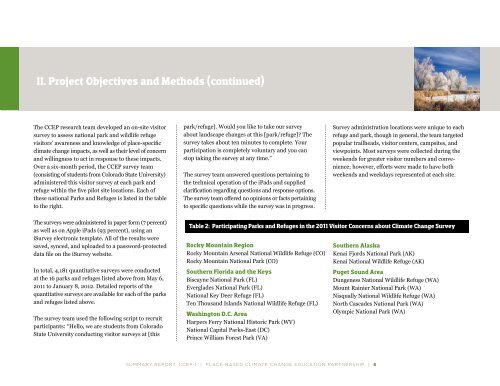Place-based Climate Change Education Partnership Report.pdf
Place-based Climate Change Education Partnership Report.pdf
Place-based Climate Change Education Partnership Report.pdf
Create successful ePaper yourself
Turn your PDF publications into a flip-book with our unique Google optimized e-Paper software.
II. Project Objectives and Methods (continued)<br />
The CCEP research team developed an on-site visitor<br />
survey to assess national park and wildlife refuge<br />
visitors’ awareness and knowledge of place-specific<br />
climate change impacts, as well as their level of concern<br />
and willingness to act in response to these impacts.<br />
Over a six-month period, the CCEP survey team<br />
(consisting of students from Colorado State University)<br />
administered this visitor survey at each park and<br />
refuge within the five pilot site locations. Each of<br />
these national Parks and Refuges is listed in the table<br />
to the right.<br />
park/refuge]. Would you like to take our survey<br />
about landscape changes at this [park/refuge]? The<br />
survey takes about ten minutes to complete. Your<br />
participation is completely voluntary and you can<br />
stop taking the survey at any time.”<br />
The survey team answered questions pertaining to<br />
the technical operation of the iPads and supplied<br />
clarification regarding questions and response options.<br />
The survey team offered no opinions or facts pertaining<br />
to specific questions while the survey was in progress.<br />
Survey administration locations were unique to each<br />
refuge and park, though in general, the team targeted<br />
popular trailheads, visitor centers, campsites, and<br />
viewpoints. Most surveys were collected during the<br />
weekends for greater visitor numbers and convenience;<br />
however, efforts were made to have both<br />
weekends and weekdays represented at each site.<br />
The surveys were administered in paper form (7 percent)<br />
as well as on Apple iPads (93 percent), using an<br />
iSurvey electronic template. All of the results were<br />
saved, synced, and uploaded to a password-protected<br />
data file on the iSurvey website.<br />
In total, 4,181 quantitative surveys were conducted<br />
at the 16 parks and refuges listed above from May 6,<br />
2011 to January 8, 2012. Detailed reports of the<br />
quantitative surveys are available for each of the parks<br />
and refuges listed above.<br />
The survey team used the following script to recruit<br />
participants: “Hello, we are students from Colorado<br />
State University conducting visitor surveys at [this<br />
Table 2: Participating Parks and Refuges in the 2011 Visitor Concerns about <strong>Climate</strong> <strong>Change</strong> Survey<br />
Rocky Mountain Region<br />
Rocky Mountain Arsenal National Wildlife Refuge (CO)<br />
Rocky Mountain National Park (CO)<br />
Southern Florida and the Keys<br />
Biscayne National Park (FL)<br />
Everglades National Park (FL)<br />
National Key Deer Refuge (FL)<br />
Ten Thousand Islands National Wildlife Refuge (FL)<br />
Washington D.C. Area<br />
Harpers Ferry National Historic Park (WV)<br />
National Capital Parks-East (DC)<br />
Prince William Forest Park (VA)<br />
Southern Alaska<br />
Kenai Fjords National Park (AK)<br />
Kenai National Wildlife Refuge (AK)<br />
Puget Sound Area<br />
Dungeness National Wildlife Refuge (WA)<br />
Mount Rainier National Park (WA)<br />
Nisqually National Wildlife Refuge (WA)<br />
North Cascades National Park (WA)<br />
Olympic National Park (WA)











